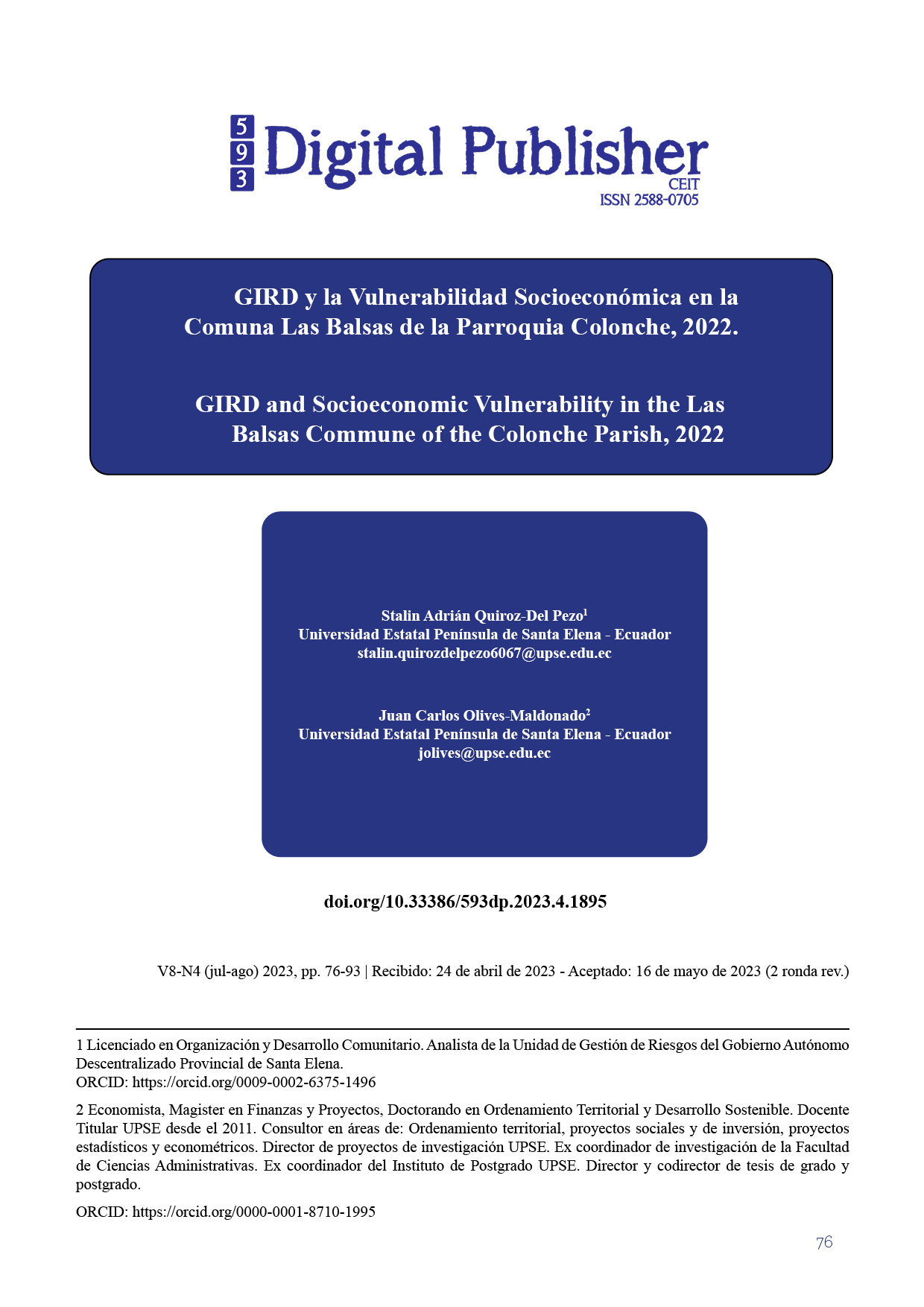GIRD and Socioeconomic Vulnerability in the Las Balsas Commune of the Colonche Parish, 2022
Main Article Content
Abstract
Within the GIRD processes, there are several methodologies that can be applied to determine socioeconomic vulnerability and its treatment for calculating risk in a given territory. In this context, it is proposed to apply a multivariate methodology of factor analysis based on principal components based on data from the 2010 population and housing census at the sector level. The methodology described is based on the premise of reduction of factors or dimensions, based on their explained variance, forming a model that describes the reality of the socioeconomic environment of the commune under a risk context. For the definition of this indicator, it is necessary to determine flooding as the main threat. Among the main results is that the census sectors with the least probability of flood risk are three, four, five, seven and eight; with median probability one and two; while the most critical sector turned out to be sector six, with the highest risk probability due to the materialization of this type of threat.
Downloads
Article Details

This work is licensed under a Creative Commons Attribution-NonCommercial-ShareAlike 4.0 International License.
1. Derechos de autor
Las obras que se publican en 593 Digital Publisher CEIT están sujetas a los siguientes términos:
1.1. 593 Digital Publisher CEIT, conserva los derechos patrimoniales (copyright) de las obras publicadas, favorece y permite la reutilización de las mismas bajo la licencia Licencia Creative Commons 4.0 de Reconocimiento-NoComercial-CompartirIgual 4.0, por lo cual se pueden copiar, usar, difundir, transmitir y exponer públicamente, siempre que:
1.1.a. Se cite la autoría y fuente original de su publicación (revista, editorial, URL).
1.1.b. No se usen para fines comerciales u onerosos.
1.1.c. Se mencione la existencia y especificaciones de esta licencia de uso.
References
Alexander, D. (2017). Improving disaster risk reduction through assessment. Natural Hazards, 647-655.
Alkire, S. (2015). Multidimensional poverty and its measurement. Oxford University Press.
Banco Interamericano de Desarrollo. (2019). Gestión de riesgos en la planificación urbana. BID. Obtenido de https://blogs.iadb.org/ciudades-sostenibles/es/gestion-de-riesgos-en-la-planificacion-urbana/
Banco Mundial. (2013). ¿Quiénes son los más pobres? Informe sobre el desarrollo mundial 2014: Gestionar el riesgo de la catástrofe. Washington, D.C.: Banco Mundial.
Banco Mundial. (2017). Informe sobre el desarrollo mundial 2017: Gobernanza y ley. Banco Mundial. Banco Mundial. Obtenido de https://openknowledge.worldbank.org/handle/10986/25823
Banco Mundial. (2019). Urban flood risk management. Banco Mundial. Obtenido de https://www.worldbank.org/en/topic/urbandevelopment/brief/urban-flood-risk-management
Cannon, T., Muller-Mahn, D., Schipper, L., Morton, J., & Twingg, J. (2013). Reducción del riesgo de desastres y adaptación al cambio climático: conceptos, conexiones y desafíos. Springer.
Cao, L., Chen, L., Zhou, H., & Wang, Y. (2017). Quantitative assessment of ecological restoration effects on reducing flood risk. Journal of Hydrology, 121-131.
Departamento Nacional de Planeación de Colombia. (2019). Planes de Ordenamiento Territorial. Bogotá: DNP. Obtenido de https://www.dnp.gov.co/programas/desarrollo-territorial/Paginas/Planes-de-Ordenamiento-Territorial.aspx
Estrategia Internacional para la Reducción de Desastres de las Naciones Unidas. (2009). Marco de Sendai para la Reducción del Riesgo de Desastres 2015-2030. Naciones Unidas. Obtenido de https://www.undrr.org/publication/sendai-framework-disaster-risk-reduction-2015-2030-spanish
GAD Santa Elena. (2020). Plan de Desarrollo y Ordenamiento Territorial del cantón Santa Elena 2019-2023. Santa Elena: GAD Santa Elena.
Galster, G. (2012). Driving urban inequality: Public policy and the roots of residential segregation. University of Kansas Press.
Hall, J. (2017). Robust decision-making under uncertainty for flood risk management: a UK application. Water Science and Technology, 3391-3399.
IFRC. (2019). World Disasters Report 2019. International Federation of Red Cross and Red Crescent Societies.
IPCC. (2021). Informe especial del IPCC sobre el océano y la criosfera en un clima cambiante. Banco Mundial. Obtenido de https://www.ipcc.ch/srocc/
Lodefalk, M. (2019). Gestión del riesgo de desastres: un enfoque transdisciplinario y multisectorial. Revista de Gestión Ambiental y Sostenibilidad, 96-109.
Lumbroso, D., Vinet, F., Stone, K., & Vinchon, C. (2018). The role of risk assessment in supporting risk-informed decisions for sustainable development. Environmental Hazards, 33-51.
Naciones Unidas. (2015). Adaptation to climate change: from resilience to transformation. Naciones Unidas.
Naciones Unidas. (2015). Agenda 2023 para el Desarrollo Sostenible. Naciones Unidas. Obtenido de https://www.un.org/sustainabledevelopment/es/objetivos-de-desarrollo-sostenible/
Naciones Unidas. (2019). Informe Mundial sobre Reducción del Riesgo de Desastres 2019. Naciones Unidas. Obtenido de https://www.unisdr.org/es/resources/global-assessment-report/archive/2019-overview
Organización de las Naciones Unidas. (2019). The Human Cost of Disasters: An Overview of the Last 20 Years (2000-2019). United Nations Office for Disaster Risk Reduction.
Oxford University. (2019). Long-term impact of floods on household incomes and debt revealed in new study. Oxford University. Obtenido de https://www.ox.ac.uk/news/2019-08-12-long-term-impact-floods-household-incomes-and-debt-revealed-new-study.
Pelling, M. (2015). Adaptation to climate change: from resilience to transformation. Routledge.
Programa de las Naciones Unidas para el Desarrollo. (2018). Ordenamiento Territorial y Desarrollo Sostenible. PNUD. Obtenido de https://www.undp.org/content/undp/es/home/librarypage/democratic-governance/local-governance/ordenamiento-territorial-y-desarrollo-sostenible.html
Programa de las Naciones Unidas para el Medio Ambiente. (2019). Informe Planeta Vivo 2018. Naciones Unidas. Obtenido de https://www.worldwildlife.org/pages/informe-planeta-vivo-2018
Schmitt , J., & Zipperer, B. (2018). State of working America wages 2018. Economic Policy Institute.
Sen, A. (1999). Development as freedom. Oxford University Press.
SNGRE. (2020). Glosario de términos de Gestión de Riesgos de Desastres. Quito: Secretaria Nacional de Gestión de Riesgos y Emergencias.
Sultana, S., & Alam, K. (2017). Community-based disaster management: a review of progress in Bangladesh. International Journal of Disaster Risk Reduction, 432-443.
Twigg, J., & Mosel, I. (2019). Understanding disaster risk: an evolving agenda. International Journal of Disaster Risk Reduction.
Twigger-Ross, C., Orr, P., Stafford, J., & Deeming, H. (2015). Communicating flood risk and mitigation: an evaluation of the Floodline service in Scotland. Journal of Flood Risk Management, 349-362.
UNICEF. (2018). Children, Climate and Disaster: Understanding and Addressing the Impacts of Climate Change on Child Rights and Well-being. United Nations Children's Fund.
Unión Internacional para la Conservación de la Naturaleza. (2020). Cambio Climático y Reducción del Riesgo de Desastres Naturales. Obtenido de https://www.iucn.org/es/content/cambio-climático-y-reducción-del-riesgo-de-desastres-naturales
UNISDR. (2015). Marco de Sendai para la Reducción del Riesgo de Desastres 2015-2030. Oficina de las Naciones Unidas para la Reducción del Riesgo de Desastres.
Walker, B., & Salt, D. (2019). Resilience practice: Building capacity to absorb disturbance and maintain function. Island Press.
Wisner, B., Gaillard, J., & Kelman, I. (2012). Framing disaster: theories and stories seeking to understand hazards, vulnerability and risk. Routledge.
Wisner, B., Gaillard, J., & Kelman, I. (2015). Handbook of disaster risk reduction & management. Routledge.



